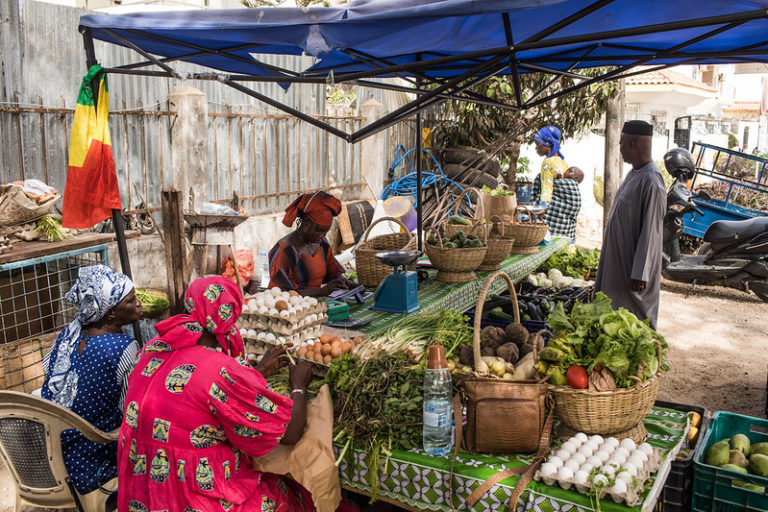The Urban Food Systems Community of Practice is a collaboration of the CGIAR Resilient Cities research initiative and World Bank to make cities green, healthy and resilient. As part of activities to mark World Cities Day, Felipe Dizon, Senior Economist, Agriculture, and Food Global Practice, World Bank, and Silvia Alonso, Senior Scientist and Epidemiologist, Animal and Human Health, ILRI, reflect on how connecting the dots between cities, food systems and the climate emergency could help pour the foundations of urban research-for-development efforts.

With each year that passes, it becomes more likely that everyone of us will live in an urban environment than a rural one. By 2050, two-thirds of us are expected to live in cities or their surrounds, and as this shift takes place, research-for-development efforts must be able to respond accordingly.
“Cities are at the nexus of food systems and the climate emergency,” says Felipe Dizon, World Bank. “They are one of the biggest contributors of CO2 emissions which in turn impacts food-producing rural areas and supply chains. Investing in research and innovations that put green, resilient, healthy, and inclusive cities at their center has the potential to bring good returns environmentally, socially, and economically but we need to move quickly to understand what the right investments and innovations are. This is the thinking behind the Urban Food Systems Community of Practice which seeks to build the knowledge products that will help guide those investments.”
Launched in November 2021, the Community of Practice was presented at the Forum for the Milan Urban Food Policy Pact (MUFPP) in October 2022. MUFPP is a collaboration of 200 cities around the world to develop more sustainable urban food systems through city-to-city and exchanges of best practices.
The CGIAR research Initiative on Resilient Cities aims to improve the diets and livelihoods of the urban poor and reduce the carbon and environmental footprints of food systems in cities of Africa, Asia and Latin America through greater access to technologies, skills and information. Led by the International Potato Center, it will focus on six cities over the next three years, with a budget of USD 30 million, and will share lessons from that experience globally.
“Bringing resilience to cities through agrifood systems requires strong connections between city governments, private industry, investors and innovation, which is why presenting CGIAR’s new research Initiative on Resilient Cities and the collaboration of CGIAR with the World Bank around Urban Food Systems at the MUFPP Forum was so significant” explains Silvia Alonso, ILRI. “For the Resilient Cities Initiative to be a success, we need to forge connections between multi-disciplinary experts, between cities, between cities and rural producers, between public and private sector stakeholders – whatever is needed to deliver safe, affordable, nutritious foods to urban poor populations. Being part of the Community of Practice will help us do this as it will facilitate information exchange and collaboration between members.”

An example of what this looks like on the ground is a strategy to improve health and hygiene at informal wet markets, an issue that gained international attention during the COVID-19 pandemic. CGIAR’s Resilient Cities Initiative is helping ensure that fresh, perishable foods sold in informal wet markets are affordable and safe, for example, by finding innovative ways to support the often-neglected informal sector, so that it delivers safer and affordable food to poor consumers and preserve the livelihood opportunities it gives to many. It will also support the development of innovations to make urban food production more efficient and more able to support the food needs of the urban citizens, all of this within planetary boundaries. In addition, the World Bank has set-up a fund for pandemic prevention, preparedness and response, to address critical gaps in investment and technical support to mitigate pandemic risks.
“The COVID pandemic was a wake-up call for many urban consumers who had never experienced such a level of food vulnerability before,” says Dizon. “We are seeing it again now with food and energy price spikes from the war in Ukraine. The climate emergency is also starting to make itself felt in rural food-producing areas which can limit the availability of fresh fruits and vegetables in cities, impacting on consumer choice and nutrition. At the same time, protecting peri-urban production areas is critical not only to provide food, but also clean water. Payment for environmental services is thus one critical linkage between cities and farms.”

An estimated 70% of global GHG emissions come from cities which in turn are getting hotter and facing more extreme weather events. While high-income cities emit the most, low-income cities are particularly exposed to the risks. Strategies such as better urban planning, for example, increasing trees and green areas in urban landscapes, can help mitigate some of these risks. Businesses can also be incentivized to innovate through processes such as public procurement schemes that reward sustainable food-systems-based enterprises, for example, reducing sugar in processed foods served in schools or turning food waste into fertilizers, or water recycling.
“A climate-smart circular bioeconomy can generate entrepreneurship opportunities, improve diets, and boost employment in poor, urban populations. Through the initiative we are particularly targeting women and young people,” says Alonso. “We also need to create better links between the city and food-producing areas through investments in infrastructure like better roads and by protecting prime agricultural land close to or within cities from disappearing under urban sprawl. Shorter food chains are more resilient and can boost the availability and affordability of fresh local produce and improve diet quality.”
